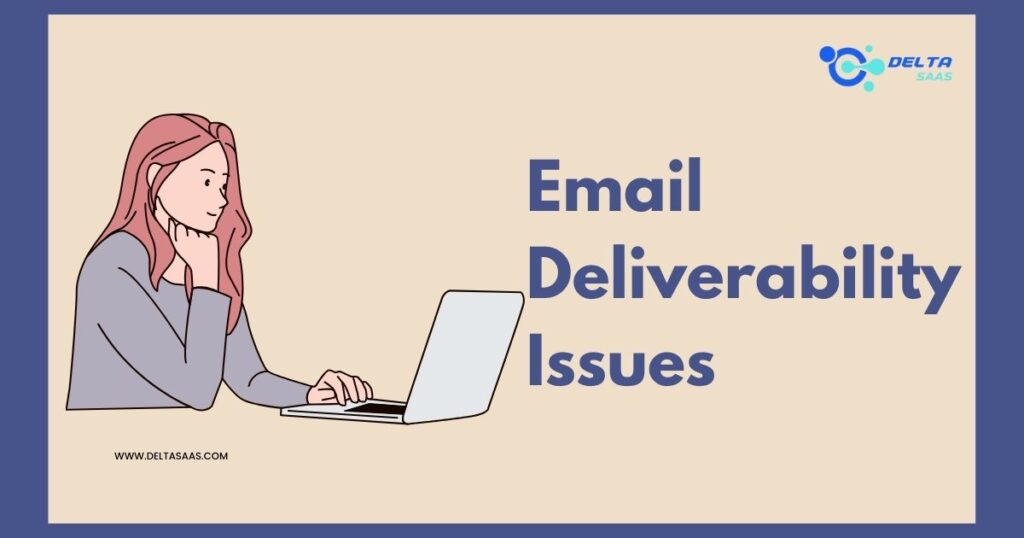Understanding Email Deliverability Issues
Email deliverability issues affect how successfully your emails reach your audience’s inbox. A low deliverability rate can harm your marketing campaigns, reduce ROI, and damage your sender’s reputation. Knowing the causes, preventive tactics, and proven strategies for improving email performance is essential to tackle these challenges.
What Is Email Deliverability?
Email deliverability measures the ability of your emails to land in recipients’ inboxes instead of spam folders—factors like sender reputation, content quality, authentication, and audience engagement impact deliverability.
Why Does Deliverability Matter?
Deliverability directly affects the success of email marketing campaigns—poor deliverability results in low open rates, weak engagement, and a poor ROI. For businesses using email marketing strategies, resolving deliverability issues ensures higher customer reach and conversion rates.
Common Causes of Email Deliverability Issues
Spam Filters and Triggers
Filters flag emails as spam if they contain specific keywords, multiple links, or poor formatting. Using phrases like “free,” excessive exclamation marks, or a high image-to-text ratio can also affect deliverability.
Authentication Issues
Proper authentication ensures your emails are legitimate. Tools like DKIM, DMARC, and SPF records authenticate your domain and prove your identity as the sender.
Poor Sender Reputation
Reputation matters. A high volume of spam complaints or emails flagged as undeliverable will hurt your credibility. Use tools to monitor your domain and mailbox reputation regularly.
Invalid or Unclean Email Lists
Sending emails to outdated or unverified email lists increases bounce rates and spam complaints. Regularly clean your list to remove inactive or fake email addresses.
Exceeding Gmail or SMTP Limits
Gmail and SMTP servers impose sending limits to prevent spam. Overstepping these limits can harm your deliverability rate.
Also Read,
Mystrika Lifetime Deal: Cold Email Made Simple
Omnisend Benefits for Email Marketing and E-commerce Success
Omnisend Pricing: Plans and Features for Businesses
Reoon Email Verifier Lifetime Deal: Validate Emails
SendFox Lifetime Deal: Simple Email Marketing
weMail Lifetime Deal: Email Campaigns for WordPress Users
ZooTools Lifetime Deal: Organize Your Workflow
How to Check for Deliverability Issues
Email Deliverability Tests
Perform free email deliverability tests using Dripify, HubSpot, or Litmus tools. These tools analyze your email content, domain health, and deliverability metrics.
Look for Red Flags
- High Bounce Rates: Indicates invalid email addresses.
- Spam Complaints: Signals that recipients find your content irrelevant.
- Low Open Rates: Often caused by poor targeting or email subject lines.
Check Your Domain Health
Use domain authentication tools like DMARC, SPF, and DKIM to verify your domain’s security and reputation. Monitor blocklists to ensure your email domain isn’t flagged.
Best Practices to Improve Email Deliverability
Maintain a Clean Email List
Regularly remove invalid addresses and use double opt-in methods to ensure subscribers want to receive your emails.
Authenticate Your Emails
Set up DKIM, SPF, and DMARC for proper email authentication. This prevents phishing and boosts the sender’s reputation.
Use Personalized Content
Write relevant email content tailored to audience segments. Avoid excessive links or spammy keywords.
Monitor Engagement Metrics
Track open rates, click-through rates, and bounce rates. High engagement signals to providers like Gmail that your emails are valuable.
Test Before Sending
Use email deliverability tools to ensure your email passes spam filters before sending.
Strategies to Overcome Email Deliverability Issues
Addressing email deliverability issues requires strategic planning, consistent monitoring, and effective email marketing practices. Below are proven techniques for optimizing email campaigns and ensuring high inbox placement rates.
Key Steps to Fix Email Deliverability Problems
Authenticate Your Domain
Authentication verifies your emails as legitimate and protects your domain from being marked as spam.
- DKIM (DomainKeys Identified Mail): Adds a cryptographic signature to validate the email’s source.
- SPF (Sender Policy Framework): Defines which servers can send emails on behalf of your domain.
- DMARC (Domain-based Message Authentication, Reporting, and Conformance): Protects your domain from unauthorized use.
Set these up through your domain host or email provider to boost trust and deliverability rates.
Improve Sender Reputation
Reputation determines whether your emails land in inboxes or spam folders.
- Monitor Complaints: Too many spam complaints harm your reputation. Use tools to track these metrics.
- Send Relevant Content: Targeted and high-quality emails reduce the chances of being flagged.
- Engage Your Audience: Build trust with subscribers to encourage positive interactions.
Email tools like HubSpot or SendGrid can be used to keep track of sender reputation metrics.
Follow Compliance Laws
Adhere to email regulations like the GDPR, CAN-SPAM Act, and CASL to maintain trust and avoid penalties.
- Include an Unsubscribe Option: Let users opt out of future emails easily.
- Avoid Misleading Subject Lines: Ensure email headers and content accurately reflect the message.
- Provide Contact Information: Include your business address to meet legal requirements.
Optimize Email Content
Content plays a significant role in deliverability. Emails flagged as irrelevant or spammy will hurt your success rate.
Tips for Writing Effective Email Content:
- To avoid Spam Triggers, Avoid using words like “urgent,” “guaranteed,” or “free.”
- Use a Text-to-Image Balance: A good mix avoids being flagged as spam.
- Limit Links: Too many links, primarily to unknown domains, trigger spam filters.
Use tools like Grammarly or Hemingway to refine your copywriting for clarity and engagement.
Segment Your Audience
Audience segmentation is an essential strategy for improving email performance.
- Group by Interests or Behavior: Tailor your message to specific segments for better relevance.
- Send Personalized Offers: Personalization increases open rates and conversions.
- Use Marketing Automation: Tools like Klaviyo and ActiveCampaign automate segmentation and campaign delivery.
Read More: Email A/B Testing Mistakes to Avoid
Advanced Tactics for Consistent Inbox Placement
Leverage Double Opt-In
Double opt-in ensures users confirm their email subscription. This reduces bounce rates and strengthens your email list.
Warm Up Your Domain
When using a new domain for email campaigns, send emails in small batches to gradually build a reputation.
Monitor Blocklists
RCheck regularly to see if your domain or IP is on any blocklists. Tools like MXToolBox help identify and resolve issues.
Tools to Monitor and Improve Deliverability
Email Deliverability Tools
- Litmus: Test your email design and deliverability before sending.
- Mail Tester: Analyze emails for potential issues with content and authentication.
- Dripify: Optimize cold email campaigns for higher open rates.
Analytics Tools
Tools like Google Analytics or HubSpot can track key performance indicators (KPIs) such as open, click-through, and bounce rates.
Benefits of Addressing Deliverability
Improving email deliverability has long-term advantages:
- Higher Open Rates: More emails reach inboxes, leading to better visibility.
- Increased Revenue: Improved engagement boosts conversions and sales.
- More substantial Reputation: Builds trust with customers and email providers.
- Optimized ROI: Efficient campaigns lead to better returns on marketing spend.
Best Practices for Maintaining High Email Deliverability Rates
Consistency is key when it comes to sustaining high email deliverability rates. Once you’ve resolved immediate issues, focus on long-term strategies to maintain inbox placement and optimize your email marketing ROI.
Read More: How to Improve Conversion Rate in Email Campaigns
Proactive Steps to Avoid Future Deliverability Issues
Clean Your Email List Regularly
Maintaining a healthy email list reduces bounce rates and ensures high engagement.
- Remove Inactive Subscribers: Identify and remove users who haven’t engaged with your emails for a long time.
- Use Email Validation ToolsTo avoid hard bounces, tools like ZeroBounce and NeverBounce verify email addresses.
Adopt a Consistent Sending Schedule
Consistency builds trust with your audience and email service providers (ESPs).
- Set Clear Expectations: Inform subscribers about the frequency of your emails during sign-up.
- Avoid Batch-and-Blast: Sudden increases in email volume can trigger spam filters.
Monitor Engagement Metrics
High engagement rates indicate that your emails provide value to recipients.
Key Metrics to Track:
- Open Rates: Indicates how often emails are opened.
- Click-Through Rates (CTR): Measures how many recipients interact with your content.
- Spam Complaints: Alerts you to issues with content relevance or targeting.
Use tools like Mailchimp or Campaign Monitor to analyze these metrics and make data-driven improvements.
Avoid Common Spam Triggers
Spammy Subject Lines
Avoid overusing capital letters, exclamation marks, or clickbait phrases.
Misleading Content
Ensure the subject line matches the email content to meet compliance laws.
Excessive Links and Images
Limit links to trusted domains and maintain a text-to-image ratio of at least 80:20.
Read More: How to Increase Click-Through Rate in Email Marketing: A Complete Guide
How Marketing Strategies Impact Deliverability
Personalization and Segmentation
Tailored emails resonate more with audiences and improve engagement metrics. Use audience segmentation to send targeted offers, newsletters, or content.
Marketing Automation
Automated tools streamline the process of personalizing and scheduling emails. Platforms like Drip and Klaviyo allow businesses to send behavior-triggered emails, improving open and click-through rates.
Social Media Integration
Encourage recipients to engage with your brand on social media. Adding social links can increase credibility and improve conversion rates.
Measuring ROI for Email Marketing
Measuring ROI is crucial for understanding the effectiveness of your campaigns.
Steps to Measure ROI:
- Track Conversions: Identify how many recipients complete desired actions (e.g., purchases or sign-ups).
- Calculate Revenue Generated: Attribute revenue to specific campaigns to gauge profitability.
- Analyze Cost-Effectiveness: Compare campaign costs with returns to refine your marketing plan.
By analyzing ROI, you can focus on strategies that maximize returns while maintaining deliverability.
Common Email Deliverability Mistakes to Avoid
Sending to Unverified Lists
Always use validated email lists to avoid high bounce rates.
Ignoring Authentication
Domains without proper authentication are more likely to be flagged as spam.
Neglecting Feedback Loops
Monitor feedback loops to promptly address issues like spam complaints or unsubscribes.
Read More: Why Is Email Marketing Ineffective? Common Issues
Conclusion
Email deliverability issues can significantly impact the success of your marketing campaiByOI by understanding the causes and implementing best practices like domain authentication, audience segmentation, and list hy, you can improve your deliverability rates and ROIgiene. Regularly monitoring and using email marketing ensures your campaigns stay practical and keep your brand ahead of the competition.
Take charge of your email strategy today, and turn challenges into opportunities for growth!
FAQs on Email Deliverability Issues
What causes email deliverability issues?
Poor sender reputation, spammy content, and unclean email lists are common causes.
How can I test email deliverability?
Use tools like Litmus or Mail Tester to analyze deliverability.
Why are my emails going to spam?
Reasons include lack of authentication, poor content quality, or spam complaints.
How do I improve my sender’s reputation?
Send relevant content, authenticate your domain, and avoid spam complaints.
What is email authentication?
Email authentication (SPF, DKIM, DMARC) verifies your emails as legitimate to providers.
How often should I clean my email list?
Clean your list every three to six months to remove inactive or invalid addresses.
What is the best text-to-image ratio for emails?
Aim for 80% text and 20% images to avoid spam filters.
How can I reduce spam complaints?
Send targeted, high-quality content and include a clear unsubscribe option.
Can cold emails affect deliverability?
Poorly executed cold email campaigns can damage your reputation and increase spam complaints.
How do I warm up a new domain?
Gradually increase email sending volume over several weeks to build trust.


